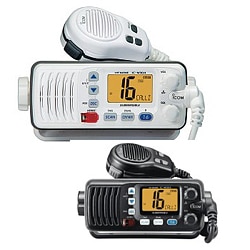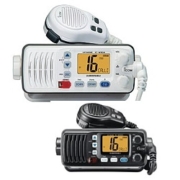Communications while Underway on a Charter
Contact between vessels, or a boat and a land station, is usually carried out using VHF (Very High Frequency) radios. The VHF is usually hard-wired to DC power in the navigation station, and its antenna can be seen at the masthead. For purposes of a charter trip, you’ll typically use the VHF radio for
- Listening to the daily weather report on a specific channel at specific times.
- Contacting the charter base about 30 minutes prior to return to base and again right before you enter port for docking instructions.
- Conversing with fellow charters on other boats
- Contacting the charter base for assistance. However, your ability to contact the base is limited by line of sight with a VHF. So if you’re behind an island or any decent distance away from the base they will not receive the signal.
You’ll be given a list of specific channels for each specific communication type by the charter base.

To activate the VHF, there will be a circuit breaker for the VHF on the control panel and also an on/off switch on the radio itself. The radio will have a knob labeled, “squelch”. Adjust squelch until static begins, then turn back until the static disappears. This enables broadcasts to be heard without static interference. The transmitter power switch controls your radio’s wattage output on broadcasts. 1W, or 1 watt, a low power setting, limits your broadcast to about a mile’s distance and should be used whenever possible to decrease radio traffic. 25W selects 25 watts of power for communications of up to about 25 miles. Another knob or button is used for channel selection. Most communications are initiated on channel 16, the universal hailing frequency. All vessels worldwide, from those on inland lakes to offshore freighters, are hailed on this “hailing” channel. Choose 16 on the channel selection knob or button to initiate a hail. Once contact is made, the parties switch to a “working channel”, such as channel 68 or 72, to carry out the conversation. Other channels are designated for more specific purposes; 22 is used to speak with the Coast Guard, and channel 13 is for contact with bridge operations for example.
To raise another vessel called for example “Ranger”, the procedure is as follows:
Turn the channel selector to channel 16, listen and wait for a clear transmission time, key the microphone, and speak in a normal voice.
- “Ranger, Ranger, Ranger. This is the sailing vessel Voyager.”
- When Ranger responds with, “Voyager, Voyager, this is Ranger, over”.
- “Ranger, Ranger, this is Voyager. Please switch to channel 68 and stand by, over.
This establishes the contact and moves the conversation to the working channel. If you can not reach the other vessel, it is common VHF etiquette to only hail three times. A word of warning here:- there are significant fines imposed by each country’s governmental communication department for misuse of VHF radio.
To end the conversation,
- “Ranger, this is Voyager clear on channel 68, standing by on 16; out”.
In the United States, the NOAA weather radio stations transmit weather information on a 24-hour per day basis. These stations may be labeled as “W-I” or Wx I, or they may be channels 1-6 on the channel selector. These are reached by dialing down to channel 6 on the normal dial, and then continuing to dial down to reach the weather channels. For example, channel “6” might appear, with the weather broadcast in progress. If not heard, proceed downward through channel 1 until reaching a broadcasting frequency. In other worldwide locations, the weather station will be given to you by the charter base.
Offshore sailing vessels communicate with either Single Sideband Radio or Satellite phone technology. Charter boats will not require this more sophisticated equipment; either the VHF radio or a cell phone should suffice.






